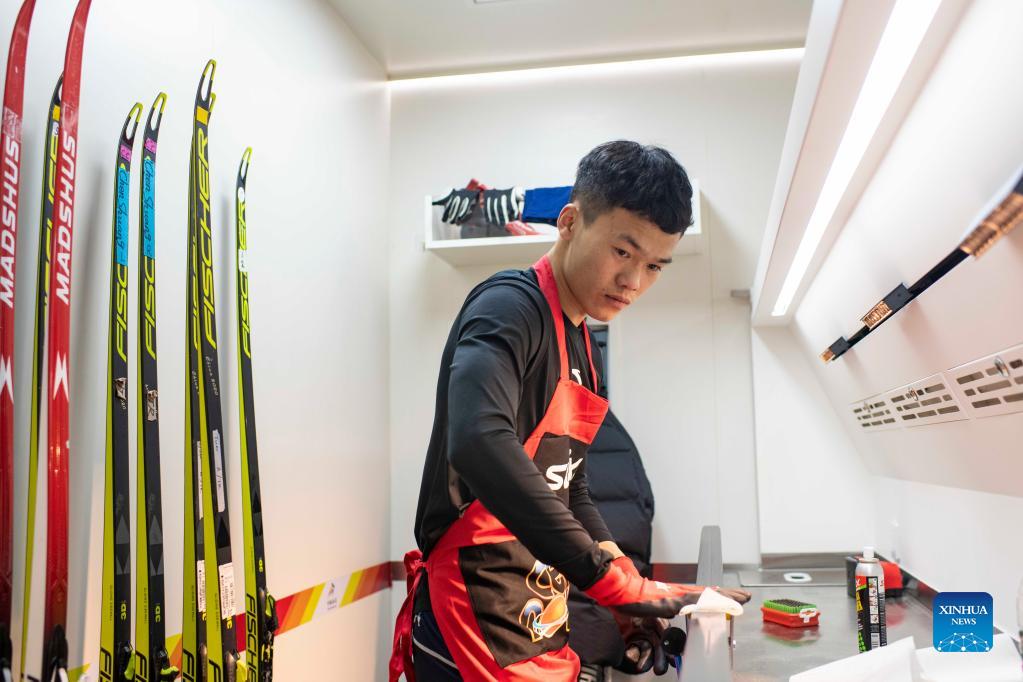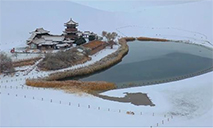China’s winter sporting equipment industry seizes chance to flourish by leaps and bounds
In recent years, China’s ice and snow sporting equipment industry has continued to thrive, feeding off an array of technical breakthroughs that have been made in recent years, along with a wide array of products that have made their presence felt in the market.

Waxing technician Chen Shuang works on a ski in the new waxing truck in Wenquan County, northwest China's Xinjiang Uygur Autonomous Region, Nov. 16, 2021. China's very first self-developed waxing truck was deployed during the Chinese national cross-country skiing team training session for the 2022 Olympic Winter Games. It comes with 6 waxing benches, cabins for storaging and other uses. (Xinhua/Hu Huhu)
According to the country’s action plan for the development of its ice and snow sporting equipment industry, by 2022, the annual sales revenue for China’s ice and snow sporting equipment industry is expected to exceed 20 billion yuan (about $3 billion), with an average annual growth rate of more than 20 percent.
The number of homemade snowmakers newly adopted at China’s ski resorts jumped from only 50 in 2015 to 467 in 2019, and the gap between new homemade snowmakers and imported ones was reduced from 600 to 215 in 2019, as indicated in a white paper on China’s skiing industry.
The fast growth of the winter sporting equipment industry in China can be evidenced by the advent of the country’s first homemade snow groomer SG400 and its first ski wax vehicle.
“The SG400 snow groomer filled the vacuum of a niche market in China,” introduced its general designer Wen Xiaoxuan. While German and Italian manufacturers dominate the global high-end market, SG400 has achieved independent intellectual property rights in core technologies such as its electro-hydraulic control system, having addressed challenges in low-temperature resistance and precision for example.
Meanwhile, China’s first homemade ski wax vehicle independently developed by several enterprises in east China's Shandong Province have adopted the use of photovoltaic power storage, 5G industrial interconnections, and other advanced technologies. During its development and design process, 66 patent applications were submitted.
“Since the beginning of this year, we have successively received orders from the Ukraine, Russia, the Netherlands, Germany and other countries. This means Chinese homemade products have re-entered the overseas market after a decade, which can be seen as an important landmark,” said Ju Peihong, general manager of Heilong Skates Co., Ltd. in Qiqihar, northeast China's Heilongjiang Province, whose production of ice skates has represented the highest standard for products of this kind during the latter half of the 20th century.
Despite the fact that the ice skate producer touched a low point at the beginning of the 21st century, it decided to seize a new opportunity to re-brand itself through acquisitions and reorganization when Beijing won its bid to host the 2022 Winter Olympics in 2015.
“Since 2015, the average annual sales of skate shoes at our company have increased by 30 percent, thanks to a marked increase in the volume of domestic orders and a recovery in overseas markets,” introduced Ju. According to the manager, his company not only expanded its business to the construction of indoor ice-skating rinks and the production of snowboards, but also launched a new generation of products newly developed in cooperation with domestic universities.
"We are currently applying for several more intellectual property rights,” said Ju, who believes that in the future more of China’s homemade ice skate shoes will be favored by athletes participating in international competitions.
Photos
Related Stories
Copyright © 2021 People's Daily Online. All Rights Reserved.










